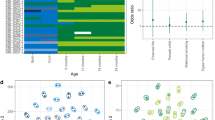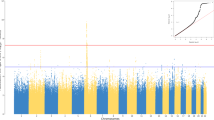Abstract
Streptococcus pneumoniae causes invasive pneumococcal disease. Delayed development of antibodies to S. pneumoniae in infancy is associated with the development of atopy and asthma. Pneumococcal surface protein C (PspC) is a vaccine candidate and variation in its choline-binding region is associated with invasive disease. This study examined 523 060 single-nucleotide polymorphisms in The Western Australian Pregnancy Cohort (Raine) Study to find loci influencing immunoglobulin G1 (IgG1) responses to PspC measured at age 14 years (n=1152). Genome-wide significance (top SNP rs9275596; P=3.1 × 10−14) was only observed at human leucocyte antigen (HLA). Imputed HLA amino-acid polymorphisms showed the strongest associations at positions DRB1 47 (P=3.2 × 10−11), 13SRG (P=9.8 × 10–10) and 11SP (P=9.8 × 10−10), and at DQA1 34 (P=6.4 × 10–10), DQB1 167R (P=9.3 × 10−6) and HLA-B 95 W (P=1.2 × 10−9). Conditional analyses showed independent contributions from DRB1 47 and DQB1 167R to the signal at rs9275596, supported by an omnibus test showing a strong signal for the haplotype DRB1_47_DQB1_167 (P=9.02 × 10−15). In silico analysis showed that DRB1 four-digit allele groups defined by DRB1 47F bind to a greater complexity of core 9-mer epitopes compared with DRB1 47Y, especially across repeats in the C-term choline-binding region. Consequent differences in CD4 T-cell help for IgG1 to PspC could have implications for vaccine design. Further analysis in other cohorts is merited.
This is a preview of subscription content, access via your institution
Access options
Subscribe to this journal
Receive 6 digital issues and online access to articles
$119.00 per year
only $19.83 per issue
Buy this article
- Purchase on Springer Link
- Instant access to full article PDF
Prices may be subject to local taxes which are calculated during checkout





Similar content being viewed by others
References
Bogaert D, van Belkum A, Sluijter M, Luijendijk A, de Groot R, Rumke HC et al. Colonisation by Streptococcus pneumoniae and Staphylococcus aureus in healthy children. Lancet 2004; 363: 1871–1872.
Bogaert D, De Groot R, Hermans PW . Streptococcus pneumoniae colonisation: the key to pneumococcal disease. Lancet Infect Dis 2004; 4: 144–154.
Browall S, Norman M, Tangrot J, Galanis I, Sjostrom K, Dagerhamn J et al. Intraclonal variations among Streptococcus pneumoniae isolates influence the likelihood of invasive disease in children. J Infect Dis 2014; 209: 377–388.
Rosenow C, Ryan P, Weiser JN, Johnson S, Fontan P, Ortqvist A et al. Contribution of novel choline-binding proteins to adherence, colonization and immunogenicity of Streptococcus pneumoniae. Mol Microbiol 1997; 25: 819–829.
Hammerschmidt S, Talay SR, Brandtzaeg P, Chhatwal GS . SpsA, a novel pneumococcal surface protein with specific binding to secretory immunoglobulin A and secretory component. Mol Microbiol 1997; 25: 1113–1124.
Cheng Q, Finkel D, Hostetter MK . Novel purification scheme and functions for a C3-binding protein from Streptococcus pneumoniae. Biochemistry 2000; 39: 5450–5457.
Janulczyk R, Iannelli F, Sjoholm AG, Pozzi G, Bjorck L . Hic, a novel surface protein of Streptococcus pneumoniae that interferes with complement function. J Biol Chem 2000; 275: 37257–37263.
Kohler S, Hallstrom T, Singh B, Riesbeck K, Sparta G, Zipfel PF et al. Binding of vitronectin and Factor H to Hic contributes to immune evasion of Streptococcus pneumoniae serotype 3. Thromb Haemost 2015; 113: 125–142.
Iannelli F, Oggioni MR, Pozzi G . Allelic variation in the highly polymorphic locus pspC of Streptococcus pneumoniae. Gene 2002; 284: 63–71.
Schachern PA, Tsuprun V, Ferrieri P, Briles DE, Goetz S, Cureoglu S et al. Pneumococcal PspA and PspC proteins: potential vaccine candidates for experimental otitis media. Int J Pediatr Otorhinolaryngol 2014; 78: 1517–1521.
Hales BJ, Chai LY, Elliot CE, Pearce LJ, Zhang G, Heinrich TK et al. Antibacterial antibody responses associated with the development of asthma in house dust mite-sensitised and non-sensitised children. Thorax 2012; 67: 321–327.
Price AL, Zaitlen NA, Reich D, Patterson N . New approaches to population stratification in genome-wide association studies. Nat Rev Genet 2010; 11: 459–463.
Aulchenko YS, Ripke S, Isaacs A, van Duijn CM . GenABEL: an R library for genome-wide association analysis. Bioinformatics 2007; 23: 1294–1296.
Rich SS, Concannon P, Erlich H, Julier C, Morahan G, Nerup J et al. The Type 1 Diabetes Genetics Consortium. Ann N Y Acad Sci 2006; 1079: 1–8.
Brooks-Walter A, Briles DE, Hollingshead SK . The pspC gene of Streptococcus pneumoniae encodes a polymorphic protein, PspC, which elicits cross-reactive antibodies to PspA and provides immunity to pneumococcal bacteremia. Infect Immun 1999; 67: 6533–6542.
Janeway Jr CA, Travers P, Walport M . Immunbiology: The Immune System in Health and Disease. 5th edn, Garland Science: New York, NY, USA, 2001.
Schneider TD, Stephens RM . Sequence logos: a new way to display consensus sequences. Nucleic Acids Res 1990; 18: 6097–6100.
Crooks GE, Hon G, Chandonia JM, Brenner SE . WebLogo: a sequence logo generator. Genome Res 2004; 14: 1188–1190.
Ranasinghe S, Cutler S, Davis I, Lu R, Soghoian DZ, Qi Y et al. Association of HLA-DRB1-restricted CD4(+) T cell responses with HIV immune control. Nat Med 2013; 19: 930–933.
Schulze zur Wiesch J, Lauer GM, Day CL, Kim AY, Ouchi K, Duncan JE et al. Broad repertoire of the CD4+ Th cell response in spontaneously controlled hepatitis C virus infection includes dominant and highly promiscuous epitopes. J Immunol 2005; 175: 3603–3613.
Hausdorff WP, Hoet B, Adegbola RA . Predicting the impact of new pneumococcal conjugate vaccines: serotype composition is not enough. Expert Rev Vaccines 2014; 14: 1–16.
Purcell S, Neale B, Todd-Brown K, Thomas L, Ferreira MA, Bender D et al. PLINK: a tool set for whole-genome association and population-based linkage analyses. Am J Hum Genet 2007; 81: 559–575.
Burton PR, Clayton DG, Cardon LR, Craddock N, Deloukas P, Duncanson A et al. Association scan of 14,500 nonsynonymous SNPs in four diseases identifies autoimmunity variants. Nat Genet 2007; 39: 1329–1337.
Price AL, Patterson NJ, Plenge RM, Weinblatt ME, Shadick NA, Reich D . Principal components analysis corrects for stratification in genome-wide association studies. Nat Genet 2006; 38: 904–909.
Hiersche M postgwas: GWAS Post-Processing Utilities. In: R package version 1.02, 2012.
Panagiotou OA, Ioannidis JP . What should the genome-wide significance threshold be? Empirical replication of borderline genetic associations. Int J Epidemiol 2012; 41: 273–286.
Pruim RJ, Welch RP, Sanna S, Teslovich TM, Chines PS, Gliedt TP et al. LocusZoom: regional visualization of genome-wide association scan results. Bioinformatics 2010; 26: 2336–2337.
Melville S NCBI2R: NCBI2R-An R package to navigate and annotate genes and SNPs. In. R package version 1.4.4 ed, 2012.
Delaneau O, Marchini J, Zagury JF . A linear complexity phasing method for thousands of genomes. Nat Methods 2012; 9: 179–181.
Howie B, Marchini J, Stephens M . Genotype imputation with thousands of genomes. G3 (Bethesda) 2011; 1: 457–470.
Jia X, Han B, Onengut-Gumuscu S, Chen WM, Concannon PJ, Rich SS et al. Imputing amino acid polymorphisms in human leukocyte antigens. PLoS One 2013; 8: e64683.
Browning BL, Browning SR . Efficient multilocus association testing for whole genome association studies using localized haplotype clustering. Genet Epidemiol 2007; 31: 365–375.
Browning BL, Browning SR . A unified approach to genotype imputation and haplotype-phase inference for large data sets of trios and unrelated individuals. Am J Hum Genet 2009; 84: 210–223.
Nielsen M, Justesen S, Lund O, Lundegaard C, Buus S . NetMHCIIpan-2.0 - Improved pan-specific HLA-DR predictions using a novel concurrent alignment and weight optimization training procedure. Immunome Res 2010; 6: 9.
Wang P, Sidney J, Kim Y, Sette A, Lund O, Nielsen M et al. Peptide binding predictions for HLA DR, DP and DQ molecules. BMC Bioinformatics 2010; 11: 568.
Olsen LR, Kudahl UJ, Simon C, Sun J, Schonbach C, Reinherz EL et al. BlockLogo: visualization of peptide and sequence motif conservation. J Immunol Methods 2013; 400-401: 37–44.
Acknowledgements
We are extremely grateful to all the families who took part in this study and the whole Raine Study team, which includes data collectors, cohort managers, data managers, clerical staff, research scientists and volunteers. The Raine Study has been supported by the National Health and Medical Research Council over the last 20 years with additional funding for core management provided by The University of Western Australia (UWA), Raine Medical Research Foundation, Telethon Kids Institute, UWA Faculty of Medicine, Dentistry and Health Sciences, Women and Infants Research Foundation, Curtin University and Edith Cowan University. The 14-year follow-up was supported by the National Health and Medical Research Council (ID 211912 and ID 003209) and The Raine Foundation. Genome-wide SNP genotyping data generated from samples collected at either the 14- or 17-year follow-ups were supported by the National Health and Medical Research Council (ID 572613). IgG1 measurements in the 14-year follow-up samples were funded by the National Health and Medical Research Council (ID 458513). Web resources: BEAGLE Software: http://faculty.washington.edu/browning/beagle/beagle.html; BlockLogo tool: http://research4.dfci.harvard.edu/cvc/blocklogo/; The Raine Study: http://www.rainestudy.telethonkids.org.au/.
Author information
Authors and Affiliations
Corresponding author
Ethics declarations
Competing interests
The authors declare no conflict of interest.
Additional information
Supplementary Information accompanies this paper on Genes and Immunity website
Rights and permissions
About this article
Cite this article
Anderson, D., Fakiola, M., Hales, B. et al. Genome-wide association study of IgG1 responses to the choline-binding protein PspC of Streptococcus pneumoniae. Genes Immun 16, 289–296 (2015). https://doi.org/10.1038/gene.2015.12
Received:
Revised:
Accepted:
Published:
Issue Date:
DOI: https://doi.org/10.1038/gene.2015.12



